I am just back from a fascinating trip that toured three central European countries: Slovenia, Croatia and Bosnia-Herzegovina. And, of course, on coming home I returned to increasingly vitriolic letters to the editor in this newspaper, our national government in chaos and unable to function, and some really rough accusations being flung in campaigns for our upcoming elections here on the Rock.
All that nastiness made me reflect on what I had learned during my visit to those Balkan countries, where neighbors have hated their neighbors for centuries because of religion and land ownership, among other things. It has led folks there to fight war after war, the most recent in 1993-96, when Bosnia especially suffered terrible loss of life and property damage. Bosnia truly is where east meets west: a third of the population is Muslim, a result of the Ottoman empire having conquered the entire area in the middle ages; another third is Serbian Orthodox Christian because of the large Serbian population; and the other third is Roman Catholic practiced by the Croatian population in Bosnia.
Yugoslavia, a benevolent dictatorship, stitched together all the Balkan nations and kept the peace for 40 years after World War II. But then Yugoslavia broke up and the old angers resurfaced, leading to the war of 1993-96. Croatia feared that Bosnian Muslims were attempting to take Croatian territory; Serbia feared that Bosnia and Croatia had their eyes on Serbian territory.
And that brings me to our visit earlier this month to Mostar, a lovely Bosnian town of about 60,000 people on the banks of the Neretva River. One thing we noticed right away were the many bombed-out buildings that remain unrepaired almost 30 years after the war ended, including one across the street from the hotel where we stayed.
We strolled across the most famous site in Mostar: its “old bridge” built in the 16th century by an Ottoman sultan. The bridge is called Stari Most, and it gave the town of Mostar its name. We watched as young Bosnia men jumped off Stari Most into the river in return for money from tourists. At night, the bridge is beautifully lit, a perfect spot for lovers to meet.
But then our tour guide broke the sad news. The “old bridge” is only 25 years old. In the last war, Croatia bombed and destroyed the 400-year-old original, claiming Muslims were using it to transport military equipment.
Once the war ended, people of Mostar quickly decided they could not live without their old bridge. They raised money from around the world and rebuilt it. Their hope emerging from despair also led them to rebuild a bombed-out mosque, a damaged Orthodox seminary and a Catholic church, among many other places. But dozens more bombed-out relics still remain, awaiting more hope and money.
All this has me worried about where our own divisions and anger might lead. Imagine if you can that some bilious element might blow up our “old bridge” across Deception Pass. Would we have enough hope and unity to rebuild it? I hope so. But I certainly pray that our issues here on the Rock never lead to the kind of things I saw in Mostar. Let’s concentrate on what we love about this place, not what divides.
Harry Anderson is a retired journalist who worked for the Los Angeles Times and now lives on Central Whidbey.



